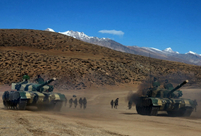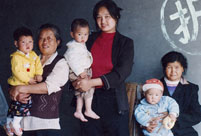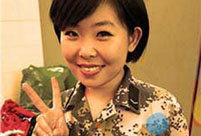 Army aviation: Adding wings to infantry
Army aviation: Adding wings to infantry
 Old photos of Chinese President Xi Jinping’s father and his families
Old photos of Chinese President Xi Jinping’s father and his families
 Bikini show in 2014 China Final of Miss Tourism World
Bikini show in 2014 China Final of Miss Tourism World
 Close-up view of August Aerobatic Team
Close-up view of August Aerobatic Team
 Goddesses married in 2014
Goddesses married in 2014
 Polar region photos raise worldwide awareness of global warming
Polar region photos raise worldwide awareness of global warming
 Get off at the last stop — Beijing Subway in vision
Get off at the last stop — Beijing Subway in vision
 Top 100 beauties in the world!
Top 100 beauties in the world!
 Gallery: Who is the most beautiful one?
Gallery: Who is the most beautiful one?
 If you like autumn, put your hands in the air!
If you like autumn, put your hands in the air!
TIANJIN, Dec. 30 -- Strolling down the broad streets in the Tianjin Economic-Technological Development Area (TEDA), it's hard to miss the flashy billboards displaying world famous brands such as Coca-Cola and Samsung.
Located at the Bohai Bay in Tianjin, a harbor city in north China, TEDA is a concentration of factories laid out in a style similar to Manhattan, though the skyline lacks highrise buildings and the streets are much quieter.
TEDA is among the first 14 state-sponsored development areas that were established in 1984, six years after China introduced the policy of reform and opening up.
The other areas were established in coastal cities including Dalian and Guangzhou.
Labor-intensive factories were common occupants of those areas when they were established. The first 20 companies set up in the TEDA during the late 1980s included a disposable lighter manufacturer and one that made cosmetics accessories.
For a long time, development area, with about 14,000 enterprises, was a manufacturing center for drinks, electronic devices and car supplies.
However, the picture is fast changing in recent years, as more and more technology companies occupy the space once held by light manufacturers. Now, more than half a million people are employed in the TEDA, including some 4,000 foreign workers.
Acting as a beacon for technological companies, China's supercomputer Tianhe-1, one of the world's fastest supercomputers, has been housed in the National Supercomputer Center in Tianjin since 2009.
The supercomputer was used to design a platform to fully digitalize the zone's planning, design, construction and property management.
Meng said Tianhe-1 computes more than 1,000 tasks every day, assisting more than 600 customers.
TEDA is also home to many small and medium-sized technology firms.
In a cafe next to the towering building bearing the name of the center is the office of Orange Family Technology (Tianjin) Co., Ltd, a hi-tech firm whose main product is a watch-sized oximeter, used in medicine to measure blood-oxygen saturation in patients.
The company decided to set up its headquarters in March in TEDA due to its favorable conditions for startups.
According to Wang Jia, an officer of the firm, TEDA provided facilities including premises, electricity and desks for the firm in a bid to attract promising startup companies and help them grow.
"The personal computers are the only properties we own here," Wang said.
Wang's company employs about 20 people, sharing the building with around 100 other high-tech companies.
Official statistics showed that there were 3,755 small and medium-sized technology firms in TEDA by the end of 2013. By November, the figure had reached 4,600.
The changes taking place in TEDA reflect China's upgrading economy and the nation's effort to encourage innovation.
At the 18th National Congress in November 2012, the Communist Party of China (CPC) put forward a strategy for innovation-driven development, stressing the importance of scientific innovation in improving productivity and overall national strength.
 Tempting Yunnan cuisine
Tempting Yunnan cuisine Joint anti-piracy drill
Joint anti-piracy drill PLA conducts tactical drill in Tibet
PLA conducts tactical drill in Tibet Beautiful Chinese woman
Beautiful Chinese woman Chestnut girl goes viral online
Chestnut girl goes viral online Time travel photos become a hit in military academies
Time travel photos become a hit in military academies Unknown 'monster' fish caught in Shandong
Unknown 'monster' fish caught in Shandong 20 years on: Relocated Three Gorges residents through lens
20 years on: Relocated Three Gorges residents through lens PLA HK Garrison veterans leave behind beautiful smiles
PLA HK Garrison veterans leave behind beautiful smiles Making sex safe
Making sex safe Gmail glitch fuels unnecessary speculation
Gmail glitch fuels unnecessary speculation Shenzhen imposes limits on purchases of new cars
Shenzhen imposes limits on purchases of new cars A Hongkonger working with mainland media confronted by both sides in Occupy Central reporting
A Hongkonger working with mainland media confronted by both sides in Occupy Central reportingDay|Week|Month